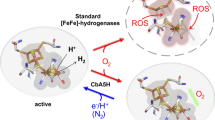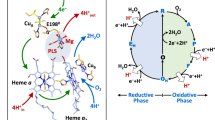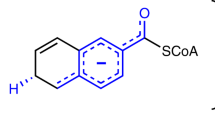Abstract
Hydrogen atoms are a vital component of enzyme structure and function1,2,3,4. In recent years, atomic resolution crystallography (≥1.2 Å) has been successfully used to investigate the role of the hydrogen atom in enzymatic catalysis5,6,7,8,9. Here, atomic resolution crystallography was used to study the effect of pH on cholesterol oxidase from Streptomyces sp., a flavoenzyme oxidoreductase. Crystallographic observations of the anionic oxidized flavin cofactor at basic pH are consistent with the UV-visible absorption profile of the enzyme and readily explain the reversible pH-dependent loss of oxidation activity. Furthermore, a hydrogen atom, positioned at an unusually short distance from the main chain carbonyl oxygen of Met122 at high pH, was observed, suggesting a previously unknown mechanism of cofactor stabilization. This study shows how a redox active site responds to changes in the enzyme's environment and how these changes are able to influence the mechanism of enzymatic catalysis.
This is a preview of subscription content, access via your institution
Access options
Subscribe to this journal
Receive 12 print issues and online access
$259.00 per year
only $21.58 per issue
Buy this article
- Purchase on Springer Link
- Instant access to full article PDF
Prices may be subject to local taxes which are calculated during checkout





Similar content being viewed by others
Change history
18 April 2006
reference 2 at end of sentence changed to superscript 2
Notes
*Note: In the version of this article initially published, the seventh sentence of the fifth paragraph is incorrect. It should read “Hydrogen atoms for the side chains were also clearly visible when the residues showed low temperature factors (typically below 8 Å2).” The error has been corrected in the HTML and PDF versions of the article.
References
Mirsky, A.E. & Pauling, L. On the structure of native, denatured, and coagulated proteins. Proc. Natl. Acad. Sci. USA 22, 439–447 (1936).
Pace, C.N., Shirley, B.A., McNutt, M. & Gajiwala, K. Forces contributing to the conformational stability of proteins. FASEB J. 10, 75–83 (1996).
Pace, C.N. Polar group burial contributes more to protein stability than nonpolar group burial. Biochemistry 40, 310–313 (2001).
Cleland, W.W. Low-barrier hydrogen bonds and enzymatic catalysis. Arch. Biochem. Biophys. 382, 1–5 (2000).
Longhi, S., Czjzek, M., Lamzin, V., Nicolas, A. & Cambillau, C. Atomic resolution (1.0 A) crystal structure of Fusarium solani cutinase: stereochemical analysis. J. Mol. Biol. 268, 779–799 (1997).
Kuhn, P. et al. The 0.78 A structure of a serine protease: Bacillus lentus subtilisin. Biochemistry 37, 13446–13452 (1998).
Katona, G. et al. X-ray structure of a serine protease acyl-enzyme complex at 0.95-A resolution. J. Biol. Chem. 277, 21962–21970 (2002).
Berisio, R. et al. Protein titration in the crystal state. J. Mol. Biol. 292, 845–854 (1999).
Lario, P.I., Sampson, N. & Vrielink, A. Sub-atomic resolution crystal structure of cholesterol oxidase: what atomic resolution crystallography reveals about enzyme mechanism and the role of the FAD cofactor in redox activity. J. Mol. Biol. 326, 1635–1650 (2003).
Dunlop, K.V., Irvin, R.T. & Hazes, B. Pros and cons of cryocrystallography: should we also collect a room-temperature data set? Acta Crystallogr. D Biol. Crystallogr. 61, 80–87 (2005).
Sampson, N.S. & Vrielink, A. Cholesterol oxidases: a study of nature's approach to protein design. Acc. Chem. Res. 36, 713–722 (2003).
Kass, I.J. & Sampson, N.S. Evaluation of the role of His447 in the reaction catalyzed by cholesterol oxidase. Biochemistry 37, 17990–18000 (1998).
Yin, Y. Functional studies to probe the active site structure of cholesterol oxidase. PhD Thesis, Department of Chemistry, State Univ. of New York, Stony Brook, New York, USA, 2002.
Hall, L.H., Orchard, B.J. & Tripathy, S.K. The structure and properties of flavins: molecular orbital study based on totally optimized geometries. II. Molecular orbital structure and electron distribution. Int. J. Quantum Chem. 31, 217–242 (1987).
Massey, V. & Ganther, H. On the interpretation of the absorption spectra of flavoproteins with special reference to D-amino acid oxidase. Biochemistry 4, 1161–1173 (1965).
Sheldrick, G.M. & Schneider, T.R. SHELXL: High-resolution refinement. in Methods in Enzymology (eds. Carter, C.W.J. & Sweet, R.M.) 319–343 (Academic Press, Boston, 1997).
Ondrechen, M.J., Clifton, J.G. & Ringe, D. THEMATICS: a simple computational predictor of enzyme function from structure. Proc. Natl. Acad. Sci. USA 98, 12473–12478 (2001).
Ko, J. et al. Statistical criteria for the identification of protein active sites using Theoretical Microscopic Titration Curves. Proteins 59, 183–195 (2005).
Hall, L.H., Orchard, B.J. & Tripathy, S.K. The structure and properties of flavins: molecular orbital study based on totally optimized geometries. I. Molecular geometry investigations. Int. J. Quantum Chem. 31, 195–216 (1987).
Hall, L.H., Bowers, M.L. & Durfor, C.N. Further consideration of flavin coenzyme biochemistry afforded by geometry-optimized molecular orbital calculations. Biochemistry 26, 7401–7409 (1987).
Li, H., Robertson, A.D. & Jensen, J.H. Very fast empirical prediction and rationalization of protein pKa values. Proteins 61, 704–721 (2005).
Bruice, T.C. & Schmir, G.L. Imidazole catalysis. II. The reaction of substituted imidazoles with phenyl acetates in aqueous solution. J. Am. Chem. Soc. 80, 148–156 (1958).
Yue, Q.K., Kass, I.J., Sampson, N.S. & Vrielink, A. Crystal structure determination of cholesterol oxidase from Streptomyces and structural characterization of key active site mutants. Biochemistry 38, 4277–4286 (1999).
Engh, R.A. & Huber, R. Accurate bond and angle parameters for X-ray protein structure refinement. Acta Crystallogr. A 47, 392–400 (1991).
McRee, D.E. XtalView/Xfit—a versatile program for manipulating atomic coordinates and electron density. J. Struct. Biol. 125, 156–165 (1999).
Vaguine, A.A., Richelle, J. & Wodak, S.J. SFCHECK: a unified set of procedures for evaluating the quality of macromolecular structure-factor data and their agreement with the atomic model. Acta Crystallogr. D Biol. Crystallogr. 55, 191–205 (1999).
Laskowski, R.A., MacArthur, M.W., Moss, D.S. & Thornton, J.M. PROCHECK: A program to check the stereochemical quality of protein structures. J. Appl. Crystallogr. 26, 283–291 (1993).
Berman, H.M. et al. The Protein Data Bank. Nucleic Acids Res. 28, 235–242 (2000).
Kleywegt, G.J. & Jones, T.A. xdlMAPMAN and xdlDATAMAN - programs for reformatting, analysis and manipulation of biomacromolecular electron-density maps and reflection data sets. Acta Crystallogr. D Biol. Crystallogr. 52, 826–828 (1996).
Emsley, P. & Cowtan, K. Coot: model-building tools for molecular graphics. Acta Crystallogr. D Biol. Crystallogr. 60, 2126–2132 (2004).
DeLano, W.L. The PyMOL molecular graphics system. (DeLano Scientific, San Carlos, California, USA, 2002). (http://www.pymol.org).
Collaborative Computational Project. N. The CCP4 suite: programs for protein crystallography. Acta Crystallogr. D 50, 760–763 (1994).
Acknowledgements
The authors thank N. Sampson for providing pure protein material for these studies and for numerous useful discussions; W. Scott, K. Karplus, G. Petsko and B. Yazar for useful discussions; T. Swartz and R. Chan for the generous loan of spectrophotometric equipment and help with data processing; and G. Gadda and M. Ghanem for their help with the interpretation of the spectroscopic results.
Author information
Authors and Affiliations
Corresponding author
Ethics declarations
Competing interests
The authors declare no competing financial interests.
Supplementary information
Supplementary Fig. 1
Spectroscopic evidence of FAD deprotonation. (PDF 315 kb)
Supplementary Fig. 2
Variation of geometric parameters of the active site His447 vs. pH. (PDF 136 kb)
Supplementary Table 1
Data collection and structure refinement statistics. (PDF 54 kb)
Supplementary Table 2
Predicted pKa values for histidine sidechains. (PDF 50 kb)
Rights and permissions
About this article
Cite this article
Lyubimov, A., Lario, P., Moustafa, I. et al. Atomic resolution crystallography reveals how changes in pH shape the protein microenvironment. Nat Chem Biol 2, 259–264 (2006). https://doi.org/10.1038/nchembio784
Received:
Accepted:
Published:
Issue Date:
DOI: https://doi.org/10.1038/nchembio784
This article is cited by
-
Computational insights for the hydride transfer and distinctive roles of key residues in cholesterol oxidase
Scientific Reports (2017)
-
An extended N-H bond, driven by a conserved second-order interaction, orients the flavin N5 orbital in cholesterol oxidase
Scientific Reports (2017)
-
Atomic resolution structure of serine protease proteinase K at ambient temperature
Scientific Reports (2017)
-
Fungal aryl-alcohol oxidase: a peroxide-producing flavoenzyme involved in lignin degradation
Applied Microbiology and Biotechnology (2012)
-
Erratum: Atomic resolution crystallography reveals how changes in pH shape the protein microenvironment
Nature Chemical Biology (2006)



